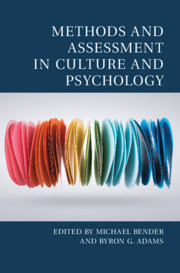Book contents
- Methods and Assessment in Culture and Psychology
- Culture and Psychology
- Methods and Assessment in Culture and Psychology
- Copyright page
- Dedication
- Additional material
- Contents
- Figures
- Tables
- Contributors
- Foreword
- 1 Introduction to Methods and Assessment in Culture and Psychology
- Part 1 Acculturation and Identity
- 2 Three Generations of Psychological Acculturation Research: Theoretical Advancements and Methodological Challenges
- 3 A Road Map for Integrating Religiosity to Acculturation Research
- 4 Identity in Remote Acculturation: Developments in Research and Methodology
- 5 Acculturation and Diversity Management at Work: The Case of Multicultural South Africa
- Part 2 Individual Differences across Cultures
- Part 3 Culture and Assessment
- Index
- References
3 - A Road Map for Integrating Religiosity to Acculturation Research
from Part 1 - Acculturation and Identity
Published online by Cambridge University Press: 21 January 2021
- Methods and Assessment in Culture and Psychology
- Culture and Psychology
- Methods and Assessment in Culture and Psychology
- Copyright page
- Dedication
- Additional material
- Contents
- Figures
- Tables
- Contributors
- Foreword
- 1 Introduction to Methods and Assessment in Culture and Psychology
- Part 1 Acculturation and Identity
- 2 Three Generations of Psychological Acculturation Research: Theoretical Advancements and Methodological Challenges
- 3 A Road Map for Integrating Religiosity to Acculturation Research
- 4 Identity in Remote Acculturation: Developments in Research and Methodology
- 5 Acculturation and Diversity Management at Work: The Case of Multicultural South Africa
- Part 2 Individual Differences across Cultures
- Part 3 Culture and Assessment
- Index
- References
Summary
Despite growing public and academic interest in the role of religion in immigrants’ lives, research focusing on a religious dimension of acculturation is still scarce. This chapter proposes an integrative acculturation framework (cf. Arends-Toth & van de Vijver, 2006) as a heuristic for conceptualizing and assessing a distinct religious dimension of acculturation conditions, orientations, and outcomes. We focus on Muslim immigrant minorities in Europe as illustrative cases and review exemplary empirical studies on (1) the processes related to religious transmission in immigrant families and communities as a critical religious acculturation condition, (2) the role of high religiosity in maintaining a distinct heritage culture and adopting the mainstream culture as acculturation orientations, and (3) the conditions under which religiosity serves as a cultural boundary maker in an intercultural context. To conclude, we encourage researchers to integrate religiosity assessment as standard practice in acculturation research.
Keywords
- Type
- Chapter
- Information
- Methods and Assessment in Culture and Psychology , pp. 41 - 61Publisher: Cambridge University PressPrint publication year: 2021

